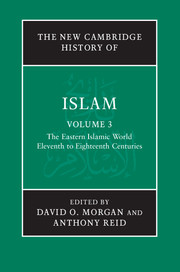Book contents
- Frontmatter
- Introduction: Islam in a plural Asia
- PART I THE IMPACT OF THE STEPPE PEOPLES
- PART II THE GUNPOWDER EMPIRES
- PART III THE MARITIME OECUMENE
- 9 Islamic trade, shipping, port-states and merchant communities in the Indian Ocean, seventh to sixteenth centuries
- 10 Early Muslim expansion in South-East Asia, eighth to fifteenth centuries
- 11 Follow the white camel: Islam in China to 1800
- 12 Islam in South-East Asia and the Indian Ocean littoral, 1500–1800: expansion, polarisation, synthesis
- 13 South-East Asian localisations of Islam and participation within a global umma, c. 1500–1800
- 14 Transition: the end of the old order – Iran in the eighteenth century
- PART IV THEMES
- Glossary
- Bibliography
- Index
- References
10 - Early Muslim expansion in South-East Asia, eighth to fifteenth centuries
from PART III - THE MARITIME OECUMENE
Published online by Cambridge University Press: 28 March 2011
- Frontmatter
- Introduction: Islam in a plural Asia
- PART I THE IMPACT OF THE STEPPE PEOPLES
- PART II THE GUNPOWDER EMPIRES
- PART III THE MARITIME OECUMENE
- 9 Islamic trade, shipping, port-states and merchant communities in the Indian Ocean, seventh to sixteenth centuries
- 10 Early Muslim expansion in South-East Asia, eighth to fifteenth centuries
- 11 Follow the white camel: Islam in China to 1800
- 12 Islam in South-East Asia and the Indian Ocean littoral, 1500–1800: expansion, polarisation, synthesis
- 13 South-East Asian localisations of Islam and participation within a global umma, c. 1500–1800
- 14 Transition: the end of the old order – Iran in the eighteenth century
- PART IV THEMES
- Glossary
- Bibliography
- Index
- References
Summary
Introduction
Islam was to come to the polities and societies of South-East Asia by sea, along the girdle of trade which extended from the Middle East through the ports of southern Asia, to South-East Asia and onwards to the southern extensions of the Chinese world in the East China Sea. Islamic influences extended into South-East Asia from both ends of this trade route in different periods. In examining historical processes, periodisation is often a helpful tool, and it is thus proposed that we examine the extension of Islam to South-East Asia up until the ninth/fifteenth century in three major stages: (1) The period from the emergence of Islam until the Cōla invasions of South-East Asia in the fifth/eleventh century; (2) The end of the fifth/eleventh century until the seventh/thirteenth century; (3) The eighth/fourteenth and ninth/fifteenth centuries, following the establishment of the first Islamic South-East Asian polities in the seventh/thirteenth century. The reconstruction of the earlier periods is of course restricted by the dearth of sources, but newly available materials from Chinese texts and the archaeological record help to extend the existing histories of the religion in the South-East Asian region. The intimate interactions between this region and the ports of southern China demand that the latter also be considered in any study of the emergence of Islam in the area we today term South-East Asia.
- Type
- Chapter
- Information
- The New Cambridge History of Islam , pp. 366 - 408Publisher: Cambridge University PressPrint publication year: 2010
References
- 6
- Cited by



